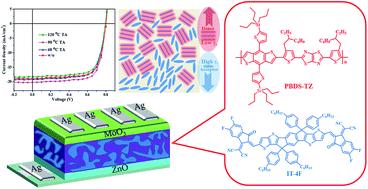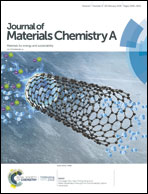A novel alkylsilyl-fused copolymer-based non-fullerene solar cell with over 12% efficiency†
Abstract
Alkylsilyl-fused copolymers are promising candidates for organic solar cells (OSCs), however, the unfavorable morphology in the active layer usually suffers from a low fill factor (FF) even upon various post-treatments. In this work, we employed the rational design of alkylsilyl-fused copolymers other than post-treatment to optimize the morphology of the active layer. By introducing the planar thiazolo[5,4-d]thiazole (TZ) unit into alkylsilyl-fused copolymers, a new copolymer donor PBDS-TZ was developed for PSCs. The σ*(Si)–π*(C) bond interaction and electron-affinity of TZ effectively downshifted the energy levels of PBDS-TZ, ensuring that it matches well with the excellent acceptor IT-4F with deeper energy levels. More importantly, without extra post-treatment, a desirable micromorphology with a vertical phase separation was readily achieved in the as-cast active layer, thanks to the intrinsic feature of the PBDS-TZ donor material. Eventually, a notable PCE of 12.01%, with a high FF of 73.1% and JSC of 20.45 mA cm−2 was obtained for the devices based on PBDS-TZ:IT-4F. These results demonstrated that rational design of conductive materials to achieve an intrinsically favorable morphology is more critical than the post-treatment for high performance PSCs.



 Please wait while we load your content...
Please wait while we load your content...